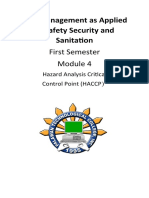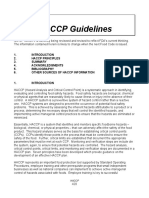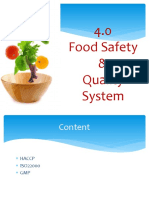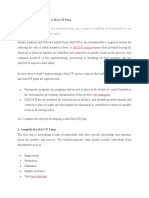05 Seatwork 1 - ARG FLORES RISK
05 Seatwork 1 - ARG FLORES RISK
Uploaded by
VenoMyyy 28Copyright:
Available Formats
05 Seatwork 1 - ARG FLORES RISK
05 Seatwork 1 - ARG FLORES RISK
Uploaded by
VenoMyyy 28Copyright
Available Formats
Share this document
Did you find this document useful?
Is this content inappropriate?
Copyright:
Available Formats
05 Seatwork 1 - ARG FLORES RISK
05 Seatwork 1 - ARG FLORES RISK
Uploaded by
VenoMyyy 28Copyright:
Available Formats
Principle 1: The first of the seven HACCP principles involves two steps.
The processes
of hazard identification and analysis are part of this HACCP stage. In accordance with
this HACCP principle, the team will compile a list of the most likely food safety risks
associated with the current product.
Principle 2: An illustration of a critical control point in the real world is maintaining the
right temperature for cooked rice. Studies indicate that the lethal Bacillus cereus
bacteria can easily infect rice. Its toxins have the potential to cause a serious food-
borne illness if consumed.
Principle 3: Physical contaminations are typically controlled by establishing an
acceptable level of the pollutant in the food. For instance, a sample batch's weight of
physical contaminants that have been sieved can be used to decide whether to accept a
shipment of sugar or reject products that do not comply.
Principle 4: These monitoring records can then be used to determine whether additional
preventative controls or repairs to the food processing facility are required.
Principle 5: Corrective action must be taken if your procedure's maximum or minimum
limits are not met. These measures are regarded as responses to non-compliance prior
to the emergence of uncontrollable conditions. Disposal, prolonged processing, and
reprocessing are among the alternatives.
Principle 6: The goal of any verification effort is to make sure that everyone on the team
is following the current HACCP system. This method can be used to figure out if your
processes need to be changed or if they are still working well.
Principle 7: The seventh principle, which calls for a comprehensive set of guidelines for
record-keeping and documentation, must be adhered to by the HACCP plan.
You might also like
- Hazard Analysis and Critical Control Points (HaccpDocument16 pagesHazard Analysis and Critical Control Points (HaccpVirendraNo ratings yet
- HACCP Questions and Answers PDFDocument5 pagesHACCP Questions and Answers PDFMLNo ratings yet
- What Is HaccpDocument6 pagesWhat Is HaccpMostafa HamdyNo ratings yet
- HACCPDocument3 pagesHACCPsp6166082No ratings yet
- Haccp: The HACCP Seven PrinciplesDocument1 pageHaccp: The HACCP Seven PrinciplesAnonymous LJ9JdSBKHNo ratings yet
- HACCPDocument8 pagesHACCPUsama AjmalNo ratings yet
- Introduction To HACCP Principles in Meat Plants: Jeff W. SavellDocument9 pagesIntroduction To HACCP Principles in Meat Plants: Jeff W. SavellDragana IlijevskaNo ratings yet
- HACCP PrinciplesDocument2 pagesHACCP PrinciplesnisbabaNo ratings yet
- HACCP PrinciplesDocument2 pagesHACCP PrinciplesnisbabaNo ratings yet
- The Seven Principles of HACCPDocument2 pagesThe Seven Principles of HACCPMagawng Ning Ja Hting NanNo ratings yet
- Hilda Samden R1806D5522255 Assignment 3 Introduction To Food ScienceDocument7 pagesHilda Samden R1806D5522255 Assignment 3 Introduction To Food Sciencesteven msusaNo ratings yet
- HACCP Stands ForDocument12 pagesHACCP Stands ForsadiqblouchNo ratings yet
- Hazard Analysis of Critical Control Points PrinciplesDocument1 pageHazard Analysis of Critical Control Points PrinciplesAsandaNo ratings yet
- HACCP Quality ControlDocument5 pagesHACCP Quality ControlLIPSITA CHOUDHURYNo ratings yet
- Module HaccpDocument13 pagesModule HaccpMark Edrian RodriguezNo ratings yet
- HaccpDocument8 pagesHaccpYant RUma ButarNo ratings yet
- Module TleDocument5 pagesModule TlejhelaicolomaNo ratings yet
- 7 Stages of Quality Control Checks For Meat and PoultryDocument2 pages7 Stages of Quality Control Checks For Meat and PoultrysureshNo ratings yet
- Process Control in The Food Industry - HACCPDocument4 pagesProcess Control in The Food Industry - HACCPJonatan VenegasNo ratings yet
- History of HACCPDocument3 pagesHistory of HACCPAndrey Gomez TabilogNo ratings yet
- Pep Haccp Training ProceduresDocument17 pagesPep Haccp Training Procedures1kumar2010100% (1)
- Seafood HACCP - BinderDocument236 pagesSeafood HACCP - BinderAndre van JaarsveldtNo ratings yet
- Audit of HACCP-IDocument11 pagesAudit of HACCP-IAgronomist ahmed hassanNo ratings yet
- Rsfs 2019 Lesson 9 PDFDocument15 pagesRsfs 2019 Lesson 9 PDFsoyNo ratings yet
- Hazard Analysis Critical Control Point 1Document12 pagesHazard Analysis Critical Control Point 1Francis BigualNo ratings yet
- HACCP (Hazard Analysis and Critical Control Point)Document11 pagesHACCP (Hazard Analysis and Critical Control Point)Aarzoo DbHlxrBFTl100% (1)
- What Is HACCP?Document2 pagesWhat Is HACCP?Tetsuya KurokoNo ratings yet
- Haccp & Iso 22000Document15 pagesHaccp & Iso 22000Nirmala RameshNo ratings yet
- Implement Food Hygiene ProceduresDocument59 pagesImplement Food Hygiene ProceduresShirmeenanwer100% (1)
- Executive Summary: Risk Management Haccp SystemDocument3 pagesExecutive Summary: Risk Management Haccp SystemFleur-de-lisNo ratings yet
- Eating Establishment RegulationsDocument9 pagesEating Establishment RegulationsThelano RapizNo ratings yet
- HACCP: Intro Approach To Food SafetyDocument34 pagesHACCP: Intro Approach To Food SafetyFranz MarasiganNo ratings yet
- Food Code HaccpDocument37 pagesFood Code HaccpjucabrerasoNo ratings yet
- HACCP and Kitchen SafetyDocument12 pagesHACCP and Kitchen SafetycecedrakeNo ratings yet
- Key Facts: The Seven HACCP PrinciplesDocument3 pagesKey Facts: The Seven HACCP PrinciplesAmaresh JhaNo ratings yet
- Chapter 4 Food Safety and Quality SystemDocument45 pagesChapter 4 Food Safety and Quality SystemIman Fatihah100% (1)
- HACCP ProjectDocument13 pagesHACCP ProjectEwart Kerry0% (1)
- Hazard Analysis and Critical Control Point (HACCP)Document10 pagesHazard Analysis and Critical Control Point (HACCP)Kemp MooreNo ratings yet
- Haccp GMP Ssop 2007Document7 pagesHaccp GMP Ssop 2007aidaNo ratings yet
- 4.0 Food Safety and Quality SystemDocument44 pages4.0 Food Safety and Quality SystemSiti Aisyah MahamudNo ratings yet
- Haccp PPP - 2Document14 pagesHaccp PPP - 2solivan_051704No ratings yet
- Food Safety and Inspection ServiceDocument3 pagesFood Safety and Inspection ServiceAnonymous Ip2ZQ1kwNo ratings yet
- Haccp 2Document34 pagesHaccp 2Haitham Abd ElwahabNo ratings yet
- Quality Certifications Relevant To Seafood Trade: Sini Joys Mathew and Josileen JoseDocument7 pagesQuality Certifications Relevant To Seafood Trade: Sini Joys Mathew and Josileen Joseudiptya_papai2007No ratings yet
- Food Safety Meha RajDocument12 pagesFood Safety Meha RajMeha RajNo ratings yet
- Developing A HACCP PlanDocument39 pagesDeveloping A HACCP PlanDarja Subotički50% (2)
- Food Safety ProgramsDocument6 pagesFood Safety ProgramsMarianosAntonioFigueroaEspinosaNo ratings yet
- HACCPDocument59 pagesHACCPbieche43No ratings yet
- Hazard Analysis Critical Control Point: HaccpDocument20 pagesHazard Analysis Critical Control Point: Haccpsitinurhaniza100% (1)
- HACCPand Food SafetyDocument25 pagesHACCPand Food SafetyAhmad RazaNo ratings yet
- 12 Steps To Develop A HACCP PlanDocument8 pages12 Steps To Develop A HACCP PlanDeavoNo ratings yet
- DDDDDDocument31 pagesDDDDDjustinreyNo ratings yet
- HACCPDocument21 pagesHACCPNur Athirah Muhamad SobriNo ratings yet
- Haccp FsslecDocument18 pagesHaccp FsslecHans JayNo ratings yet
- 20161111221133haccp NotesDocument6 pages20161111221133haccp NotesfeddyNo ratings yet
- Ohs W12Document11 pagesOhs W12Angelica Magdamit GicaldeNo ratings yet
- FSMS AwarenessDocument117 pagesFSMS AwarenesstusharNo ratings yet
- DIKSHADocument15 pagesDIKSHARaj KamalNo ratings yet
- Test Food Safety 2Document7 pagesTest Food Safety 2Danial Iqhwan100% (1)
- 11 Task Performance TNT ExpressDocument3 pages11 Task Performance TNT ExpressVenoMyyy 28No ratings yet
- 12 Activity 1 - ARG FLORESDocument2 pages12 Activity 1 - ARG FLORESVenoMyyy 28No ratings yet
- 11 Task Performance - ARG Lloyd's Register GroupDocument3 pages11 Task Performance - ARG Lloyd's Register GroupVenoMyyy 28No ratings yet
- 11 Task Performance - ARG CCPDocument2 pages11 Task Performance - ARG CCPVenoMyyy 28No ratings yet
- 11 Task Performance - ARG STMicroelectronicsDocument3 pages11 Task Performance - ARG STMicroelectronicsVenoMyyy 28No ratings yet
- 02 Task Performance 1 - ARG QUALITY SERVICEFlores - Baylosis - BegenioDocument3 pages02 Task Performance 1 - ARG QUALITY SERVICEFlores - Baylosis - BegenioVenoMyyy 28No ratings yet
- 07 Worksheet 1 - ARGDocument1 page07 Worksheet 1 - ARGVenoMyyy 28No ratings yet
- Amarita Resort BoholDocument2 pagesAmarita Resort BoholVenoMyyy 28No ratings yet
- 05 Task Performance 1 Flores Great BooksDocument5 pages05 Task Performance 1 Flores Great BooksVenoMyyy 28No ratings yet
- 1001 NightsDocument6 pages1001 NightsVenoMyyy 28No ratings yet
- 01 eLMS Activity 4 Great BooksDocument1 page01 eLMS Activity 4 Great BooksVenoMyyy 28No ratings yet
- 03 Lab 01Document2 pages03 Lab 01VenoMyyy 28No ratings yet
- 03 Review 1 - ARG TQMDocument1 page03 Review 1 - ARG TQMVenoMyyy 28No ratings yet
- 2 Performance Task 1 FloresJoMilesBSITDocument5 pages2 Performance Task 1 FloresJoMilesBSITVenoMyyy 28No ratings yet
- 01 Activity 1 - ARG Flores QuantitativeDocument1 page01 Activity 1 - ARG Flores QuantitativeVenoMyyy 28No ratings yet
- 09 Quiz 13 PDFDocument2 pages09 Quiz 13 PDFVenoMyyy 28No ratings yet
- 10 Review 1 - ARGDocument2 pages10 Review 1 - ARGVenoMyyy 28No ratings yet
- 10 Activity 1 - ARG FloresDocument3 pages10 Activity 1 - ARG FloresVenoMyyy 28No ratings yet
- 10 Task Performance 1 - ARG FloresDocument5 pages10 Task Performance 1 - ARG FloresVenoMyyy 28No ratings yet
- 10 Task Performance 1 - ARG FAELDONEADocument5 pages10 Task Performance 1 - ARG FAELDONEAVenoMyyy 28No ratings yet















































































